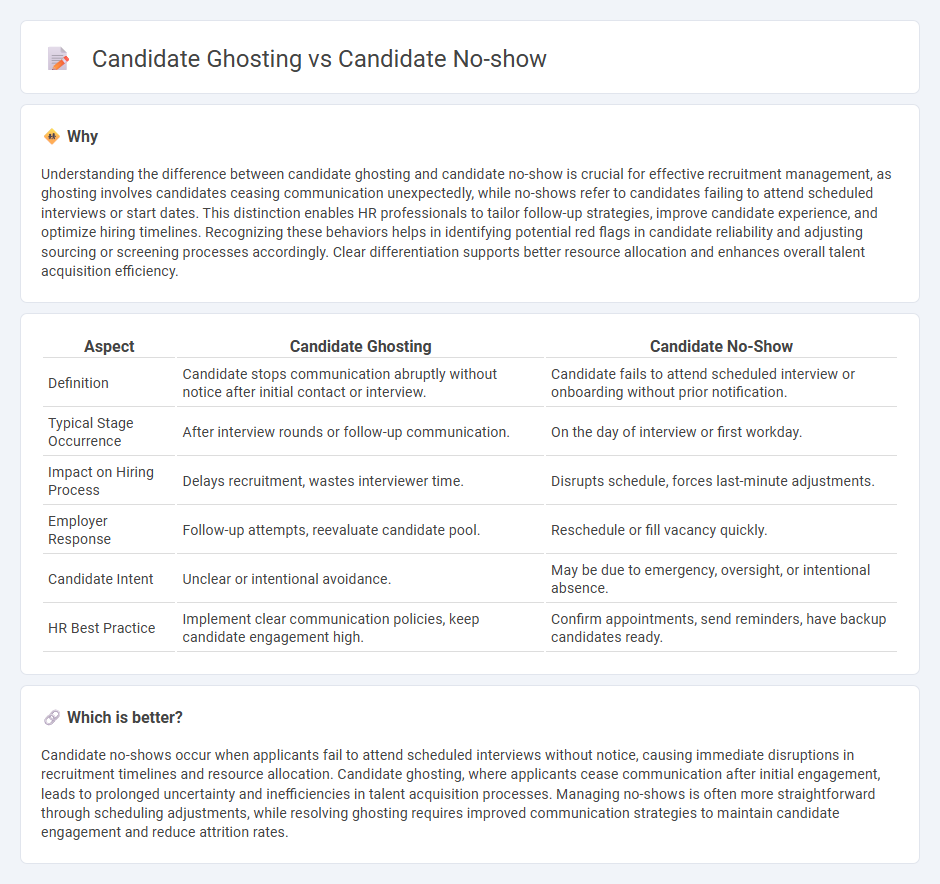
Candidate ghosting occurs when applicants suddenly cease communication after initial contact or interviews, leaving employers without closure or feedback. Candidate no-shows refer to individuals who fail to appear for scheduled interviews or onboarding without prior notice, impacting recruitment timelines and hiring efficiency. Explore strategies to effectively manage and reduce both ghosting and no-show instances in human resources.
Why it is important
Understanding the difference between candidate ghosting and candidate no-show is crucial for effective recruitment management, as ghosting involves candidates ceasing communication unexpectedly, while no-shows refer to candidates failing to attend scheduled interviews or start dates. This distinction enables HR professionals to tailor follow-up strategies, improve candidate experience, and optimize hiring timelines. Recognizing these behaviors helps in identifying potential red flags in candidate reliability and adjusting sourcing or screening processes accordingly. Clear differentiation supports better resource allocation and enhances overall talent acquisition efficiency.
Comparison Table
| Aspect | Candidate Ghosting | Candidate No-Show |
|---|---|---|
| Definition | Candidate stops communication abruptly without notice after initial contact or interview. | Candidate fails to attend scheduled interview or onboarding without prior notification. |
| Typical Stage Occurrence | After interview rounds or follow-up communication. | On the day of interview or first workday. |
| Impact on Hiring Process | Delays recruitment, wastes interviewer time. | Disrupts schedule, forces last-minute adjustments. |
| Employer Response | Follow-up attempts, reevaluate candidate pool. | Reschedule or fill vacancy quickly. |
| Candidate Intent | Unclear or intentional avoidance. | May be due to emergency, oversight, or intentional absence. |
| HR Best Practice | Implement clear communication policies, keep candidate engagement high. | Confirm appointments, send reminders, have backup candidates ready. |
Which is better?
Candidate no-shows occur when applicants fail to attend scheduled interviews without notice, causing immediate disruptions in recruitment timelines and resource allocation. Candidate ghosting, where applicants cease communication after initial engagement, leads to prolonged uncertainty and inefficiencies in talent acquisition processes. Managing no-shows is often more straightforward through scheduling adjustments, while resolving ghosting requires improved communication strategies to maintain candidate engagement and reduce attrition rates.
Connection
Candidate ghosting and candidate no-show both represent critical challenges in Human Resources recruitment processes, reflecting a candidate's failure to communicate or appear for scheduled interviews or job offers. These behaviors disrupt talent acquisition timelines, increase hiring costs, and can signal poor employer branding or candidate experience issues. Addressing these phenomena involves enhancing communication strategies, setting clear expectations, and leveraging technology to improve candidate engagement and retention.
Key Terms
Communication Breakdown
Candidate no-show occurs when an applicant fails to attend a scheduled interview without prior notice, while candidate ghosting involves sudden cessation of all communication after initial interactions. Both scenarios highlight critical communication breakdowns that disrupt recruitment workflows and delay hiring processes. Explore effective strategies to prevent candidate communication failures and improve engagement.
Recruitment Process
Candidate no-show occurs when a job seeker fails to attend a scheduled interview without prior notice, disrupting the recruitment process and causing time inefficiencies for hiring teams. Candidate ghosting involves candidates suddenly ceasing communication during any stage of the recruitment cycle, leaving employers uncertain about their status and complicating talent pipeline management. Explore effective strategies to minimize both no-shows and ghosting in recruitment processes.
Employer Branding
Candidate no-show occurs when an applicant fails to attend a scheduled interview without prior notice, negatively impacting the employer's recruitment timeline and resource allocation. Candidate ghosting refers to a candidate disappearing during or after the hiring process, causing frustration and potential damage to the employer's reputation. Explore effective strategies to enhance employer branding and reduce the impact of candidate no-shows and ghosting.
 dowidth.com
dowidth.com